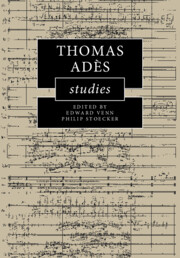Book contents
- Thomas Adès Studies
- Thomas Adès Studies
- Copyright page
- Dedication
- Contents
- Figures
- Tables
- Music Examples
- Online Materials
- Contributors
- Preface
- Acknowledgements
- Notes on the Text
- 1 ‘Chronically volatile’
- 2 Performing Adès
- 3 ‘Fountain of Youth’, ‘River of Meaning’
- 4 ‘Oh brave new Caliban’
- 5 Chaconnes in the Music of Adès
- 6 Closing the Circle?
- 7 A World in Constant Motion
- 8 Musique automatique? Adèsian Automata and the Logic of Disjuncture
- 9 Narrating the Dance of Death
- 10 Hearing Voices in Adès’s Operas
- 11 The RICH Logic of Adès’s The Exterminating Angel and The Tempest
- 12 Sonic Allegory in Adès’s The Exterminating Angel
- Bibliography
- Index
1 - ‘Chronically volatile’
Gesture in Adès’s Living Toys and America: A Prophecy
Published online by Cambridge University Press: 18 November 2021
- Thomas Adès Studies
- Thomas Adès Studies
- Copyright page
- Dedication
- Contents
- Figures
- Tables
- Music Examples
- Online Materials
- Contributors
- Preface
- Acknowledgements
- Notes on the Text
- 1 ‘Chronically volatile’
- 2 Performing Adès
- 3 ‘Fountain of Youth’, ‘River of Meaning’
- 4 ‘Oh brave new Caliban’
- 5 Chaconnes in the Music of Adès
- 6 Closing the Circle?
- 7 A World in Constant Motion
- 8 Musique automatique? Adèsian Automata and the Logic of Disjuncture
- 9 Narrating the Dance of Death
- 10 Hearing Voices in Adès’s Operas
- 11 The RICH Logic of Adès’s The Exterminating Angel and The Tempest
- 12 Sonic Allegory in Adès’s The Exterminating Angel
- Bibliography
- Index
Summary
The chapter explores two of Adès’s early works – Living Toys for fourteen players (1993) and America: A Prophecy, for soprano solo and orchestra with optional chorus (1999) – from the perspective of gesture as an 'energetic shaping' of sound (after Robert Hatten). Analyses synthesise small-scale events to wider emergent dramatic and expressive networks. The 'volatile' gestural sequence in Living Toys is a function of the score’s overtly programmatic scheme of seven dream-like scenarios, with a returning 'Hero’s' theme centre-stage in a score rich in agent-like instrumental solos. In America, gesture communicates a historical-mythic sequence, evoking the impending catastrophe of the sixteenth-century military conquest of Mayan civilisation by Spanish conquistadors. History runs its awful course in a sequence recounted verbally by the solo soprano as priestess. A gestural perspective elucidates Adès’s large-scale drama of complex images. Fracturings of musical tempo create an image of Mayan calendrical movement: triadic brass music evokes the moment of encounter, a 'battle' scene.
- Type
- Chapter
- Information
- Thomas Adès Studies , pp. 1 - 26Publisher: Cambridge University PressPrint publication year: 2021
- 1
- Cited by

